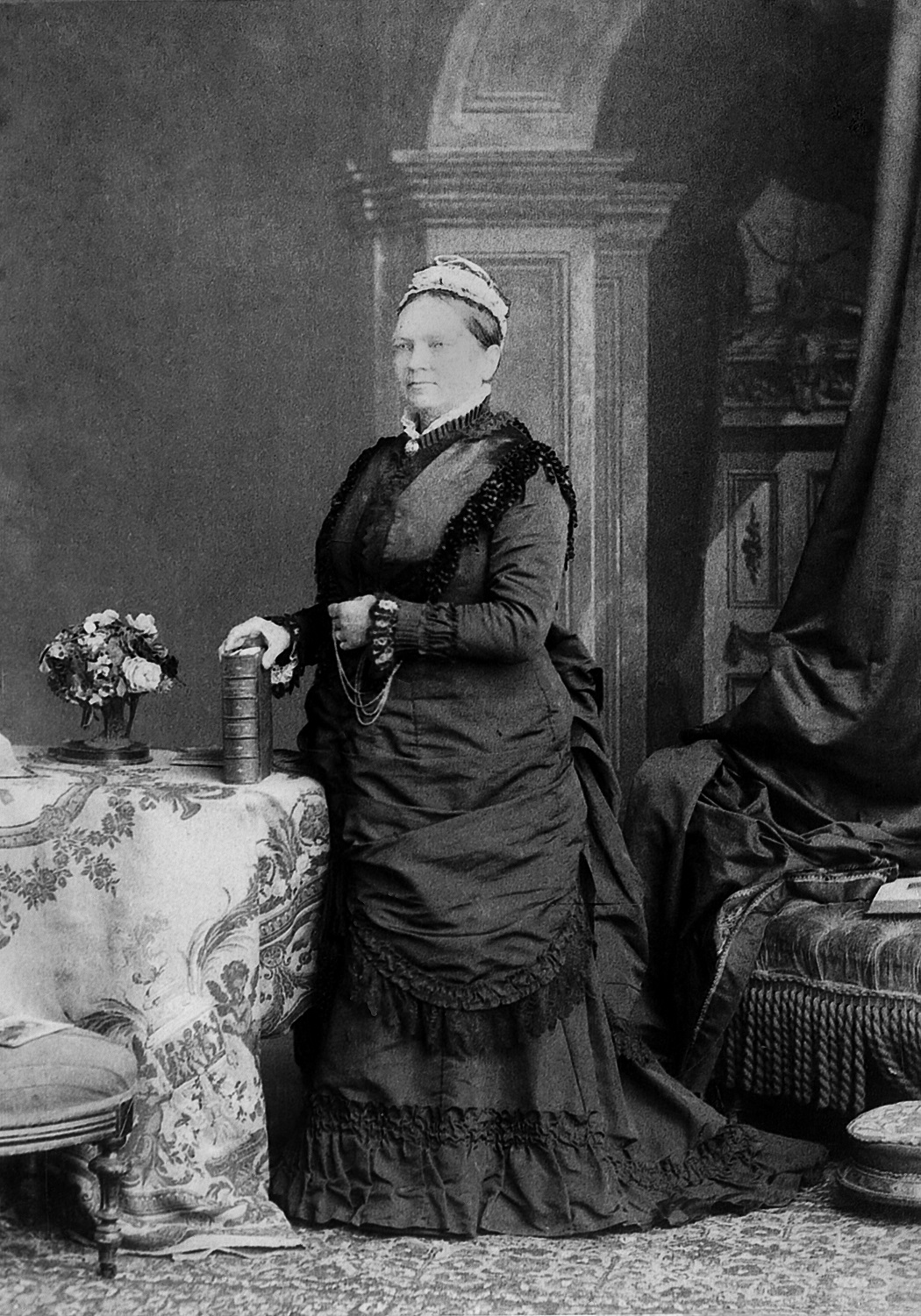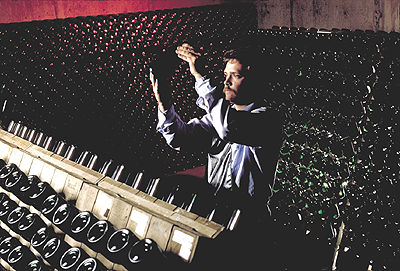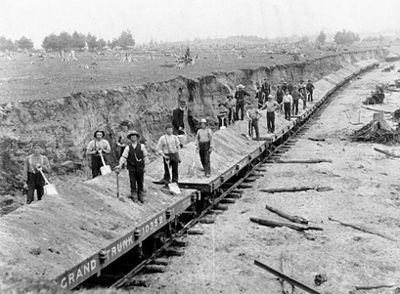Moosehead Breweries Limited, the maker of Moosehead Canadian Lager, is the oldest family-owned brewing company in Canada. Located in Saint John, New Brunswick, the company has been family owned and controlled for six generations and is currently led by founders Susannah and John Oland’s great-great-great grandson, Andrew Oland. Moosehead is the fourth-largest brewing company in Canada — after Molson, Labatt and Sleeman — and the last major brewery to be owned by Canadians. Moosehead beer is sold throughout Canada, in many locations in the United States, and in 15 countries around the world. The company brews 19 beers under 10 brands, including its mainstay Moosehead Canadian Lager, as well as James Ready, Alpine and Hop City. It also contract brews for six companies, including Samuel Adams, from the United States, and Estrella Damm, from Spain. Moosehead is a privately owned company and does not disclose its financial information; however, in 2018, market researchers estimated the company held as high as 3.8 per cent of the Canadian beer market and would generate $247.1 million in revenue.

Susannah and John Oland
John Oland was born on 14 July 1819 in Bristol, England. His family was of modest means and as a result he worked a variety of jobs before marrying Susannah Culverwell in 1842. Together the couple had nine children. John moved from job to job after he and Susannah married, working as a cigar dealer, draper, shopkeeper, commercial clerk, accountant and more. His restless spirit, however, made it difficult for him to hold a job for an extended period of time and ultimately undermined his financial security; he was forced to file for bankruptcy in 1844. He subsequently studied accounting and began to work for the London and Southwestern Railroad. The family soon thereafter began farming in nearby Surrey. Almost penniless, John decided in 1862 to emigrate to British North America, leaving Susannah to tend to family and farm. In 1865, Susannah and the children joined John in Truro, Nova Scotia, which was witnessing an upswing in economic activity due to the construction of the railroad (see Railway History).

Establishing the Brewery, 1867
By 1867, the Oland family had moved to Dartmouth. Struggling financially, Susannah supplemented what little money John earned by making beer in the shed at the back of their Dartmouth property, using an old family recipe. Her October brown ale proved to be so popular with the local inhabitants that a family friend, Captain Francis Walter DeWinton (1835–1901), suggested brewing on a larger scale. DeWinton, along with two other investors, provided the funds to start a commercial brewery. Because they began the business in the Turtle Grove area of Dartmouth — a Mi’kmaq community — the brewery was named Turtle Grove Brewery. The company was incorporated on 1 October 1867. On paper, John Oland was manager of the business, but in reality, Susannah oversaw virtually every aspect of its day-to-day operations. By many accounts, she supervised the brewing process, which was undertaken with the help of her three sons. (See also Notable Women Entrepreneurs in Canadian History.)
The new commercial brewery was situated on a 12.5-acre plot with 300 feet of frontage on Halifax Harbour. Halifax was ideal for a budding brewer because of the pronounced military and naval presence. Beer had long been part of the life in the armed forces. During the War of the Spanish Succession (1701–1714), the Duke of Marlborough, commander of the British forces, proclaimed: “No soldier can fight unless he is properly fed on beef and beer.” British authorities accepted Marlborough’s statement as gospel, and in the years that followed, British soldiers were given enough “beer money” to purchase five pints of beer a day. This, along with the fact that the overwhelming majority of the civilian population in Dartmouth and Halifax could trace its ancestry to the beer-drinking cultures of England, Scotland, and Ireland, gave an immediate incentive to anyone like Susannah Oland looking to capitalize on their knowledge of the art of brewing.
Taking advantage of DeWinton’s connections (he was military secretary to the Marquess of Lorne, the governor general of Canada), the brewery quickly grew to be the third-largest business operating in Dartmouth. Tragedy struck in October 1870, however, when John died in a riding accident. To make matters worse, DeWinton was transferred to Gibraltar and the other two partners sold their interests to a manager, George Fraser, who had formerly been employed at a competing brewery. Undaunted, Susannah Oland and her sons continued working at the brewery, which had been renamed the Army and Navy Brewery in honor of its principal patrons.

In 1877, after receiving an inheritance from a relative in England, Susannah Oland bought out Fraser and dissolved the partnership.She began operating the brewery under the name S. Oland, Sons and Company and trained her sons to be brewmasters. She worked at the brewery for the remainder of her life.

When Susannah died in 1885, the brewery was taken over by her youngest son, George W. C. Oland. In 1895, George sold the brewery to an English syndicate and used the proceeds to acquire the Highland Spring Brewery of Halifax. The Halifax brewery was destroyed in the explosion of 1917 (see Halifax Explosion). As a consequence, in 1918, George W. C. Oland purchased the Red Ball Brewery in Saint John. The Red Ball Brewery was first run by his son George Bauld and later by Geoffrey (see Halifax Explosion). His second son, Sidney, joined him in the business at the end of the First World War, and with the aid of government compensation for victims of the Halifax explosion, the Olands rebuilt the old Highland Spring Brewery.

Prohibition and Oland Family Rift
During Prohibition, when the sale of intoxicating beverages was illegal, the Olands supplemented the little money they made from soft drinks and 2 per cent beer, which was legal to produce, with profits from selling illegal “strong” beer in pubs and shops. In 1927, George Bauld admitted to selling illegal beer to various pubs and shops, which cost his business some $24,000 in fines over the course of Prohibition. This dodgy practice helped keep the business afloat. In 1928, Oland & Sons purchased the Alexander Keith’s Brewery when it came up for sale. Keith’s was the oldest brewery in the Maritimes and its acquisition gave Oland & Sons a monopoly on brewing in Nova Scotia.

Soon after the Oland family acquired the Keith’s brewery, Sidney Oland’s older brother, George Bauld Oland, acquired the James Ready Brewery in Saint John, which was renamed New Brunswick Breweries (and again renamed Moosehead Breweries Limited in 1947). In 1933, George Bauld introduced Moosehead Pale Ale to the public. Ever since they were boys, Sidney and George had been in competition with one another. While their father was alive, the intense rivalry was never allowed to descend into a family feud. But when George Sr. died in 1933, the brothers went their separate ways. By the end of the Second World War, there were two distinct branches of the Oland family: the Nova Scotia Olands, who owned and operated the Alexander Keith’s Brewery, and the New Brunswick Olands, who controlled Moosehead. Eventually, control of the Moosehead brewery in Saint John was given to George Bauld’s son, Philip, while Oland & Sons of Halifax was taken over by Sidney’s three sons Victor, Bruce, and Don.
Postwar Consolidation in the Brewing Industry
After the Second World War, the Canadian brewing industry became consolidated in the hands of the three largest brewing companies: Labatt, Molson and Canadian Breweries Limited. Interprovincial trade barriers, provincial jurisdiction over the retail sale and distribution of alcoholic beverages, local sensitivities, as well as a permissive policy toward takeovers paved the route towards market consolidation in Canada. By 1962, the “big three” produced almost 95 per cent of the beer sold in Canada. Just over 50 of the 61 breweries that were in operation in 1945 were still producing beer by the early 1960s, but most were owned by one of these three. The big three had a physical presence in every region across the country, except for the Maritimes and Northern Ontario, and their national brands dominated the market place
The limited size of the market as well as the protective provincial tariff on out-of-province beer sheltered Moosehead from its big three competitors. Nevertheless, Moosehead encountered difficulties during the postwar years due to the lingering shadow of Prohibition. While Prohibition had come to an end in New Brunswick in 1927, public drinking continued to be prohibited until 1961. This led to some of the lowest consumption rates of beer in Canada. To make matters worse, Moosehead was unable to gain market share outside of New Brunswick. The size of the firm’s advertising budget, a conservative corporate culture and the barriers to entry across the nation meant that Moosehead would remain a regional player. Knowing the drinking laws were about to be liberalized in 1962, Moosehead’s salesmen unleashed draft beer on the province. This preemptive strike allowed Moosehead to dominate the draft market for decades to come. By 1970, Moosehead controlled roughly half of the Maritime markets.
Throughout the period, Moosehead continued to do what it did best: make and market beer. This was not the case with the “big three,” which during the 1970s and 1980s embraced a strategy of diversification. In place of specialization for higher returns, they substituted diversification in hopes of greater security. Labatt, for instance, diversified into frozen foods, juice, dairy, grain and entertainment, which included bringing the Blue Jays to Toronto. It was a similar story at Molson, which diversified into chemicals and the home improvement sector, spending hundreds of millions of dollars to purchase shares in Beaver Lumber and Home Depot.
The Moose is Loose: Expansion to American Markets
Moosehead, however, did not follow this trend. Instead, it attempted to boost sales by finding a new market for its core product. In 1975, Derek Oland, the son of then chairman Philip Oland, suggested that Moosehead should push into the US, a venture pitched by American importers. In the past, Canadian brewers had tried to break into the highly competitive American market but failed. Philip Oland was therefore skeptical of the merits of such a manoeuvre. Nevertheless, Derek Oland continued to make the case, and after three years of deliberation, Moosehead made its move.
Moosehead’s management realized that marketing was key to the company’s success. As a result, the packaging of the firm’s flagship beer was redesigned to give the brew a more Canadian look. Its blue and white foil label was replaced with a green label featuring the head of a moose and the words “Moosehead Canadian Lager Beer.” The label was intended to have a rustic feel and create a sense of the great Canadian outdoors. The brand was also promoted as a premium product and priced accordingly. Instead of a mainstream advertising campaign, Moosehead placed its product in highly visible areas in retail outlets and bars and gave away promotional items such as T-shirts emblazoned with the slogan “The Moose is Loose.”
The initial campaign had its desired effect. When Moosehead first became available in the United States in 1978 the company sold 96,000 cases, almost twice as many as it had anticipated. The brand was especially popular among students of the American Northeast. At its peak, Moosehead sold six million cases in a single year in the US. Success in the US encouraged an upswing in domestic sales. When provincial trade barriers came down in 1992, Moosehead expanded across the nation. By the end of the 2010s, it was the fourth-largest Canadian brewer and the largest one that was not majority foreign owned.
Richard Oland Murder
In 2011, Richard Oland was murdered at his office in Saint John. Oland was a former vice president of Moosehead Breweries Ltd. and the younger brother of Moosehead executive chairman Derek Oland. Given the Oland family’s renown in New Brunswick and the brutal nature of the murder, the case drew national attention. Richard’s son Dennis was convicted of the murder in 2015. His conviction, however, was overturned by the New Brunswick Court of Appeal in 2016. In 2019, Dennis Oland was found not guilty of second-degree murder in a retrial (see Dennis Oland Case).
Stolen Moosehead Cases
In August 2004, a shipment of more than 50,000 cans of Moosehead bound for Mexico went missing. The driver responsible for the shipment was arrested in Ontario and later sentenced to 19 months in jail. Most of the beer, easily identified by its Spanish-language labeling, was recovered by police and citizens. According to an RCMP news release: “Six of the cans were discovered with bite marks in them indicating a bear had, at one point, been into the beer.”
Given the quirky nature of the event, the story made international headlines. Seizing on the free publicity, Moosehead sold T-shirts that read “Beer Heist Tour ‘04” and made opportune statements to the media saying, “If someone offers you a cold Moosehead in a can that has Spanish on it, the beer is hot.”
In September 2007, an even larger shipment of Moosehead — 77,000 cans and 44,000 bottles — was stolen in Mississauga, Ontario. A company spokesman urged Moosehead drinkers to “stock up,” and told a reporter that, “It strikes us the thieves obviously know what the consumers want.” One person was arrested for theft that October.
Hop City Brewing Co.
During the mid-2000s, small-scale craft breweries grew steadily in popularity and increased their sales considerably, prompting major brewing companies to acquire those brands or establish their own. In 2009, Moosehead responded to the craft beer revolution by establishing its own microbrewery in Brampton, Ontario, called Hop City Brewing Co. Hop City brews such brands as Barking Squirrel and Hop Bot IPA.
Awards
- Gold (Alpine Lager), American Lager/Ale or Cream Ale, World Beer Cup (2000)
- Silver (Moosehead Light), American Lager/Ale or Cream Ale, World Beer Cup (2000)
- Bronze (Moosehead Lager), American-Style Premium Lager, World Beer Cup (2002)
- Bronze (Moosehead Lager), American-Style Premium Lager, World Beer Cup (2004)
- Gold, Monde Selection (2005)
- Gold (Moosehead Pale Ale), North American Style Blonde or Golden Ale, Canadian Brewing Awards (2015)
- Gold (Alpine Lager), North American Style Lager, Canadian Brewing Awards (2016)
- Silver (Moosehead Cracked Canoe), Light (Calorie-Reduced) Lager, Canadian Brewing Awards (2016)
- Bronze (Moosehead Lager), North American Style Premium Lager, Canadian Brewing Awards (2017)
- Bronze (Moosehead Cracked Canoe), Light (Calorie-Reduced) Lager, Canadian Brewing Awards (2017)
- Silver (Moosehead Small Batch Ten Penny Stock Ale), English Style Pale Ale, Canadian Brewing Awards (2019)
- Bronze (Moosehead Small Batch Honey Wheat Ale), Special Honey/Maple Lager or Ale, Canadian Brewing Awards (2019)
- Gold (Moosehead Small Batch Sugar Bush), Special Honey/Maple Lager or Ale, Canadian Brewing Awards (2019)
- Bronze (Cracked Canoe), Light (Calorie-Reduced) Lager, Canadian Brewing Awards (2020)
- Gold (Moosehead Shaker Tropical Pina Colada), Experimental Beer, Canadian Brewing Awards (2020)
- Silver (Moosehead Small Batch Rauchbier), Smoked Beer, Canadian Brewing Awards (2020)
- Bronze (Grapefruit Radler), Fruit/Fruit Wheat/Field/Pumpkin Beer, Canadian Brewing Awards (2021)

 Share on Facebook
Share on Facebook Share on X
Share on X Share by Email
Share by Email Share on Google Classroom
Share on Google Classroom
















